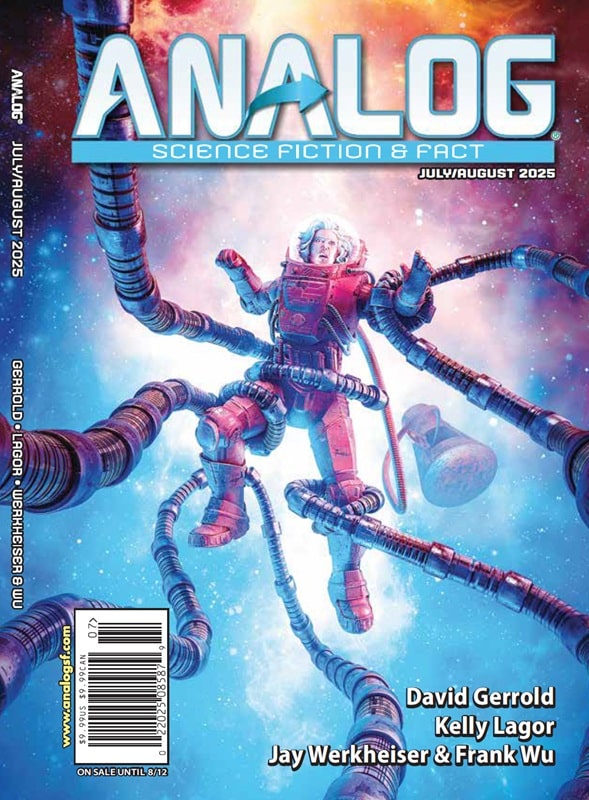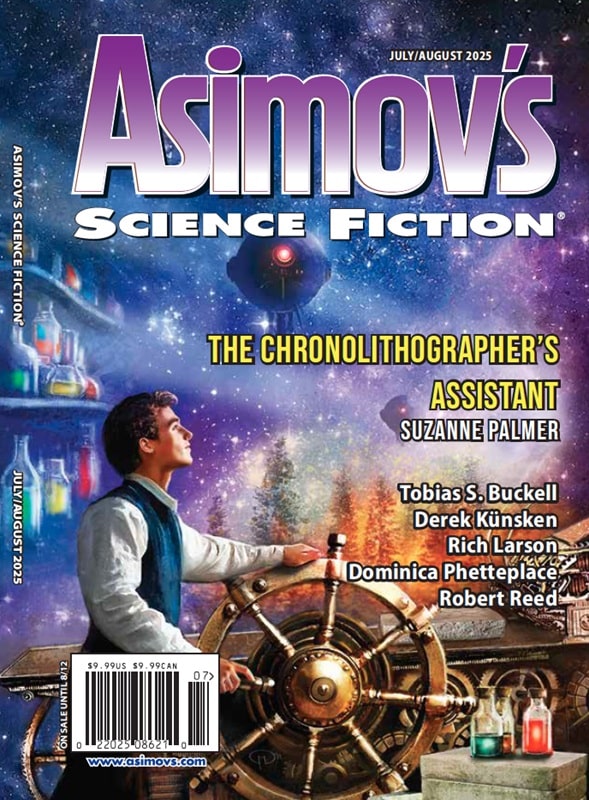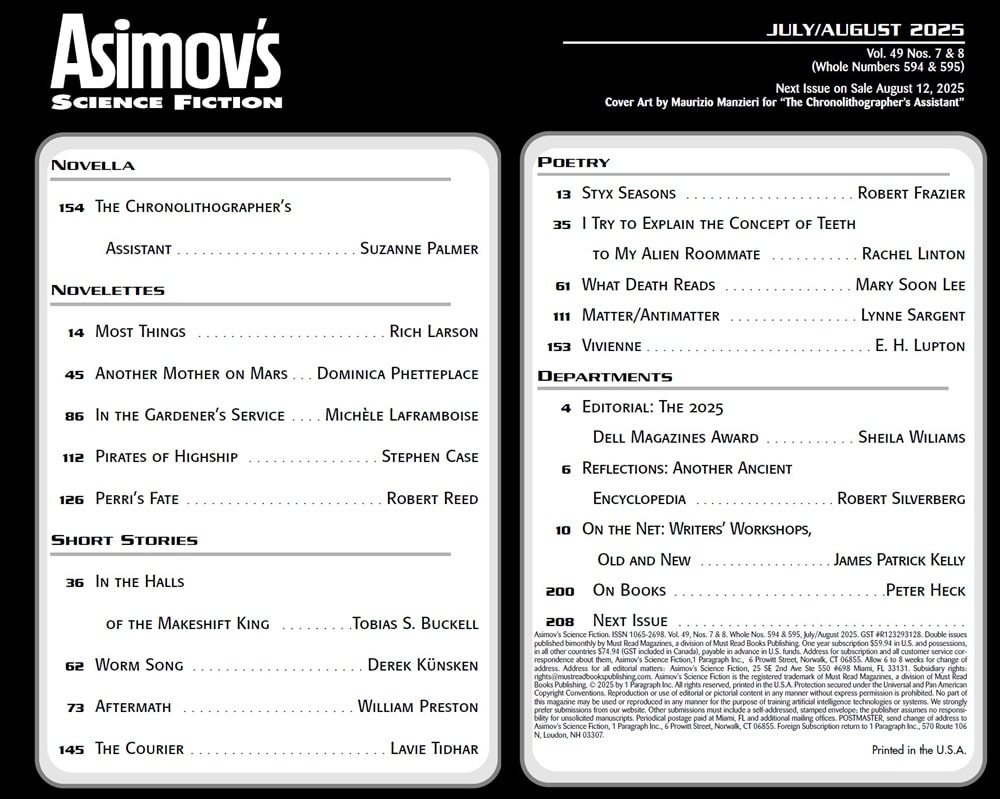Hive Mind Weddings, Worm Songs, and Space Pirates: July-August Print Science Fiction Magazines
 |
 |
July-August 2025 issues of Analog Science Fiction & Fact and Asimov’s Science
Fiction. Cover art by GrandeDuc/Shutterstock, and Maurizio Manzieri
Back in February the last surviving print science fiction magazines, Analog, Asimov’s Science Fiction, and The Magazine of Fantasy & Science Fiction, were sold to Must Read Books, a new publisher backed by a small group of genre fans. I was apprehensive about what that meant for all three magazines, and indeed there were several hiccups, especially related to distribution. I had to wait more than a month after the on-sale dates for the July/August issues of Asimov’s SF and Analog to show up at my local bookstore, for example. But show up they did, and in fact the new September/October issues seem to be arriving more or less on time. Now if only we could see a new issue of F&SF…
The July/August issues are just as enticing as usual, with contributions from Rich Larson, David Gerrold, Suzanne Palmer, Dominica Phetteplace, Stephen Case, Robert Reed, Tobias S. Buckell, Derek Künsken, William Preston, Lavie Tidhar, Mary Soon Lee, Shane Tourtelotte, M. Ian Bell, Sean Monaghan, and many more.
[Click the images for bigger versions.]
Sam Tomaino at SFRevu enjoyed the latest Analog.
“Desert Soul” by David Gullen
In this future, interstellar travel had been controlled by AIs. But they went insane, killing a huge number of people. Now, they just use suspended animation for travelling long distances. On a planet, Thab owns his boat and hires it out for travel. A woman named Nybeck from off-planet hires him for a special journey, to find the last AI so she can kill it. This starts a nice little adventure story with a good ending.
“Patient Was the Doctor” by Victoria N. Shi
Our narrator is a psychologist specializing in end-of-life counseling hired by the government to treat an octopus-like alien who was shot down by the military and is dying. He has his own struggles, including the efforts of he and his wife to have a baby. The story ends with an interesting twist and a positive note. A good read.
“ESRI” by James Dick
This is a sequel to “EDIE” in the January/February 2023 issue. This is what I wrote about that: “EDIE is the Europa Deep Ice Explorer and has reached Europa after a seven-year voyage… Odd things begin happening as soon as she lands. First, dome-like structures appear on the surface and grow bigger, then stubby stalks rise from them. They are all equidistant from each other. Things get really strange when an ice sculpture of EDIE appears.”
Now, on January 1st, 2060, a third probe, named ESRI (Europa Sample Return Initiative), has been sent… Approaching Europa are two other spacecraft, one from Israel, the other from China. They will not land until ESRI’s rockets have taken off back to Earth. Part of the story is about Kate’s loving relationship with her mother, who is dying but supportive. A glitch occurs when the Chinese probe lands early, forcing the ESRI team to move up their return date. Great characterization here. The end of the story is both bittersweet and beautiful. We are promised a third concluding story, which I look forward to,
“The Marks We Leave” by M. Ian Bell
Rylek is a humanoid alien who makes changes to things to insure mankind’s survival. This is over hundreds of years. But the loss of his friend Caro has made him so sensitive to loss that he actually replaces humans who have died. This is something his superior feels has to change. Interesting tale.
“Ready for New Arrivals?” by Sean Monaghan
Two astronauts, Aphrodite and Justin, are tethered together exploring Ganymede, one of the moons of Jupiter. Justin falls in a hole and blacks out. Aphrodite needs to rescue him. That comes with an interesting plot twist, which makes for the usual good story we get from Monaghan
The fiction concludes with the novella, “Under the Moons of Venus: A Tale of a Princess Altiviolant” by Jay Werkheiser & Frank Wu.
Our narrator is a scientist and expert in hieroglyphics, named Boxhammer, who approaches William Herschel in 1769 just before an upcoming transit of Venus, which they can observe through their telescopes and see, once and for all, if it has any moons.Boxhammer is given an ancient scroll by a man who had caused him trouble before, Lord Albrecht Lamprecht. It is in hieroglyphics and tells of people from Earth who had been transported there by the god Thoth after the Great Flood. They dwell in floating cities while two artificial moons provide oxygen and a magnetic field for their protection. The story tells of a princess of those people who is kidnapped by pirates but finds the protective moons are failing and they must return to Earth. We get a great adventure story with the princess having to deal with strange creatures, betrayals by people she trusted and other perils to accomplish this. The story is more Edgar Rice Burroughs than hard science, but it is a lot of fun.
Read Sam’s complete review here.
The new Asimov’s is reviewed by Mina at Tangent Online. Here’s an excerpt.
“Most Things” by Rich Larson starts off feeling like Pulp Fiction on drugs, with two guys coming down from a high and picking up a kidnapping contract. But is it a real kidnapping if your kidnappee is clearly paying you to kidnap them? When you find yourself being chased by a quantum creature and government goons — is the monster truly a monster and what happens when you make First Contact with a quantum universe? The only thing that kept me going at the beginning was that it was well-written and that I do have a soft spot for Schroedinger’s kitty. The story did eventually become worth the read and the ending is a nice surprise.
“Worm Song” by Derek Künsken is simply beautiful. It’s well-written and like a haunting melody. A cloud colony is using the native dragons to search and mine for minerals in a gas giant, as they can safely plunge through all the gas layers due to their hard carapaces. But the dragons are dying out. Jiayi has had her ears and part of her olfactory system replaced by dragon tissue. She can hear the song of the “worms” that fly in the upper levels but she also feels alienated from the people around her, including her once-beloved partner. She smuggles a worm into the lower layers with surprising results. I would happily read this again!
“In the Gardener’s Service” by Michèle Laframboise has really good world building. Sirius is sent by the Emperor to rescue his kidnapped cousin. But it is not a simple rescue as Sirius negotiates a dangerous garden and double-crossing politics. It is a good adventure story with a soupçon of James Bond thrown in. I particularly enjoyed how we are given just enough information about a complex culture.
In “Pirates of Highship” by Stephen Case, Odeem is convinced the gas planet, Highship, is an intelligent mind. He likens the atmospheric storms to brain activity. He creates algorithms to talk to that mind and he needs an array to broadcast and listen via an implant in his own brain. Throw in a couple of pirates and the best laid plans can go awry. Odeem succeeds in initiating communication between the algorithms and the planet, with unexpected results. An interesting look at the nature of consciousness.
“The Courier” by Lavie Tidhar is a day in the life of a courier on Mars. Yara enjoys speeding across the sands as she delivers and picks up packages. Her day includes delivering a wedding proposal from one hive mind to another, sentient coffee machines and potted godlings who try to spread love and cheer. Gently humorous.
“The Chronolithographer’s Assistant” by Suzanne Palmer is wonderful. The best stories are always the ones where characters show growth: the protagonist, Thomas, is an anxious mess at first. He fears the sea and so cannot become a fisherman. In desperation, he approaches Mrs Hammond and asks to become her assistant in her chromolithography workshop. He suddenly finds himself mixed up in time travel and a daring rescue in the future… Do read and savour this novella!
Read Mina’s full review here.
Here’s all the details on the latest SF print mags.
Analog Science Fiction & Science Fact
Editor Trevor Quachri gives us a tantalizing summary of the current issue online, as usual.
We have “North Station Blues,” a creative setting with some equally creative solutions to its problems, from David Gerrold, and “Under the Moons of Venus,” a bit of retro Planetary Romance (with an Analog twist, naturally) from frequent collaborators Jay Werkheiser and Frank Wu, as well as a look at ancient RNA as a building block for life in our fact article for the issue, “Out of ‘Some Warm Little Pond’ Pt. I: ‘Rifters’ and the RNA World” by Kelly Lagor.
What’s that? More, you say? Okay, then how about some Vancian adventure in David Gullen’s “Desert Soul” or a slice of biological gig economy in “Jennifer Does Pushups” by Joseph Webber? Perhaps a look inside “The First Velodrome on Mars,” courtesy Marie Vibbert, or a father/daughter near-future survival story in Matthew Claxton’s “Low Tide Survival”? The titular “Last Dam Standing” from Dawn Vogel? Well, there’s all that, and more besides!
You don’t want to miss it!
Here’s the full TOC.
Novella
“Under the Moons of Venus: A Tale of a Princess Altiviolant” by Jay Werkheiser & Frank Wu
Novelettes
“North Station Blues” by David Gerrold
“Desert Soul” by David Gullen
“ESRI” by James Dick
Short Stories
“The First Velodrome on Mars” by Marie Vibbert
“Hidden Achievement” by Shane Tourtelotte
“Patient Was the Doctor” by Victoria N. Shi
“Last Dam Standing” by Dawn Vogel
“If the Algorithms Are Gentle” by Bernie Jean Schiebeling
“Low-Tide Salvage” by Matthew Claxton
“Jennifer Does Pushups” by Joseph Weber
“Imaginary” by Daniel D. Villani
“The Marks We Leave” by M. Ian Bell
“Ready for New Arrivals?” by Sean Monaghan
Flash Fiction
“Your Entry to Paradise™ Memorial Experience” by Robert Morrell Jr
Science Fact
Out of “Some Warm Little Pond,” Part I: “Rifters” and the RNA World by Kelly Lagor
Poetry
Our Lady of the Atom, by Josh Pearce
Mother Hubble’s Elegy for Rhessi, by Sandra J. Lindow
Reader’s Departments
Guest Editorial: Three Gates, by Stephen Barmes
Analytical Laboratory Results
Biolog: Kelly Lagor, by Richard A. Lovett
In Times to Come
The Alternate View, by John G. Cramer
Unknowns, edited by Alec NevalaLee:
Back to Square One, by Rachel Fabi
The Reference Library, by Rosemary Clare Smith
Brass Tacks

Asimov’s Science Fiction
Sheila Williams provides a handy summary of the latest issue of Asimov’s at the website.
In the July/August 2025 issue, Suzanne Palmer treats us to an astonishing novella. “The Chronolithographer’s Assistant” tells the suspenseful story of a young man and an enigmatic older woman that mostly takes place in a nineteenth-century fishing village. This is a truly captivating and beautifully told tale!
Rich Larson’s lethal imagination offers us a lyrical story about “Most Things”; Michèle Laframboise sets us up for intrigue “In the Gardener’s Service”; Derek Künsken uncovers the truth about “Worm Songs” on a distant planet; well known author Tobias S. Buckell makes his Asimov’s debut with a tale about the mechanisms “In the Halls of the Makeshift King”; Dominica Phetteplate depicts deeply disturbing event’s in “Another Mother on Mars”; and we remain on the Red Planet with Lavie Tidhar to spend a day accompanying “The Courier”; William Preston’s short story observes a great span of time in “The Aftermath”; You’re in for an adventure with “The Pirates of Highship” by Stephen Case; and Robert Reed finally reveals “Perri’s Fate” on The Great Ship.
You’ll find our July/August 2025 issue on sale at newsstands on June 10, 2025. Or subscribe to Asimov’s—in paper format or our own downloadable varieties—by visiting us online at www.asimovs.com. We’re also available individually or by subscription via Amazon.com’s Kindle Unlimited, BarnesandNoble.com’s Nook, and Magzter.com/magazines!
Here’s the complete Table of Contents.
Novellas
“The Chronolithographer’s Assistant” by Suzanne Palmer
Novelettes
“Most Things” by Rich Larson
“Another Mother on Mars” by Dominica Phetteplace
“In the Gardener’s Service” by Michèle Laframboise
“Pirates of Highship” by Stephen Case
“Perri’s Fate” by Robert Reed
Short Stories
“In the Halls of Makeshift King” by Tobias S. Buckell
“Worm Song” by Derek Künsken
“Aftermath” by William Preston
“The Courier” by Lavie Tidhar
Poetry
Styx Seasons by Robert Frazier
Try to Explain the Concept of Teeth to My Alien Roommate by Rachel Linton
What Death Reads by Mary Soon Lee
Matter/Antimatter by Lynne Sargent
Vivienne by E.H. Lupton
Departments
Editorial: The 2025 Dell Magazines Award by Sheila Williams
Reflections: Another Ancient Encyclopedia by Robert Silverberg
On the Net: Writer’s Workshops, Old and New by James Patrick Kelly
Thought Experiment: Crime and Punishment in Stanley Kubrick’s A Clockwork Orange by Kelly Lagor
On Books by Peter Heck
Next Issue
Analog, Asimov’s Science Fiction and The Magazine of Fantasy & Science Fiction are available wherever magazines are sold, and at various online outlets. Buy single issues and subscriptions at the links below.
Asimov’s Science Fiction (208 pages, $9.99 per issue, one year sub $57.75 in the US) — edited by Sheila Williams
Analog Science Fiction and Fact (208 pages, $9.99 per issue, one year sub $57.75 in the US) — edited by Trevor Quachri
The Magazine of Fantasy & Science Fiction (256 pages, $10.99 per issue, one year sub $65.94 in the US) — edited by Sheree Renée Thomas
The July-August issues of Asimov’s and Analog are officially on sale until August 12, but given the bumpy nationwide distribution recently, may well be on shelves a little longer than that. See our coverage of the May-June issues here, and all our recent magazine coverage here.